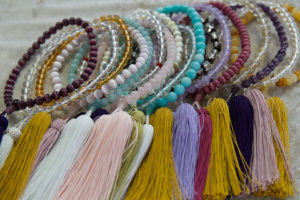A discussion about wooden prayer beads.
The materials for prayer beads come in various types and colors.
The materials for prayer beads come in a variety of options, often referred to as “Juzu” or “Nenju” in Japan, and there’s a rich diversity in their composition. Apart from commonly used materials like wood, seeds, and natural stones, there’s a wide range of options, including amber, animal bones, and horns, as well as marine products such as coral, pearls, abalone, and more.
Among these choices, certain materials gained prominence due to their significance in scriptures, abundant availability in regions with a strong tradition of prayer bead crafting, or their aesthetic appeal. Notably, dense and sturdy premium woods like “Karaki” sourced from China and Southeast Asia, as well as woods like ebony and rosewood, are highly prized not only for their visual beauty but also for their practical durability. As a result, they have become widely popular materials for crafting prayer beads. “Kara” signifies ancient China, and “Ki” refers to wood.
High-quality wood, yet affordable?
Based on economic principles, when a large quantity is in circulation, prices tend to decrease. Even now, you can purchase Karaki (premium wood) prayer beads at a very affordable price.
Now, this is my own speculation, but it seems that in the past, the technology for processing stones was not as advanced as it is today. Thus, the high cost of premium materials was more due to the labor involved in mining and processing rather than the intrinsic value of the material.
In recent years, well-processed natural stones have become available at lower prices. However, in Japan, where woodworking has a long history, the traditional price distinction between wood (inexpensive) and stone (expensive) hasn’t changed. Similar religious items made of beads, such as the Rosary in Christianity and the Tasbih in Islam, are found all over the world. Just as in some places, water can be more expensive than oil, there may be countries where wood is more expensive than stone, depending on the region.
In the industry, there have been rumors that countries exporting Karaki and wood seeds to Japan are reducing their supply. The demand for Karaki may be declining, not only for prayer beads but also for traditional Japanese room pillars and other uses. It’s likely that the volume of supply will continue to decrease in the future.
The value of wooden prayer beads.
However, unfortunately, it’s unlikely that hastily acquiring Karaki (premium wood) prayer beads will result in a rapid surge in their value, akin to precious gems. Unless you happen to possess large quantities of exceptionally large pieces suitable for construction purposes, the scenario is quite different.
As a criterion for choosing prayer beads, some people consider their “asset value.” While these beads may not reach the price levels of traditional assets, it’s a consideration. For example, if a set of prayer beads is priced at 10,000 yen, does it genuinely hold a value equivalent to that amount? Can you retain that value over time? These are the questions that some individuals ponder.
The industry has its share of unscrupulous practices, so it’s essential to have at least a basic knowledge and exercise caution when making a selection. However, it’s also a somewhat disheartening fact that one can only determine the quality based on such criteria. Frankly speaking, when it comes to determining whether the value matches the price, being cautious about where you shop might be a more prudent approach than solely relying on the product.
This advice doesn’t apply exclusively to prayer beads but extends to the broader notion that “expensive equals good” or “cheap means poor quality” is not always true. It’s about cherishing the value these items hold for you personally when making your choices.

The merits of wooden prayer beads.
Wooden prayer beads have several advantages. They are lightweight and durable. Those who use them frequently often appreciate the warm, tactile sensation in their hands during the winter.
Moreover, wooden prayer beads are known for their resilience even with extensive use. They are less likely to break or wear out quickly.
Another distinctive feature is that wooden prayer beads tend to show signs of aging more prominently compared to stones. This aspect can be subjective, as some may perceive it as becoming “vintage” while others might say it gains a certain “character.” There’s no right or wrong answer here. Many people prefer wooden prayer beads because they enjoy observing these gradual changes over time.
However, if you’re looking for something more ornate, natural stones often take the lead in terms of elegance. For those who find themselves torn between the two, a design that combines wooden prayer beads as the main bead with natural stones for the accessories (such as the “parent bead,” “two heaven beads,” and “bosa”) might be a compelling option. There are plenty of variations to explore.


